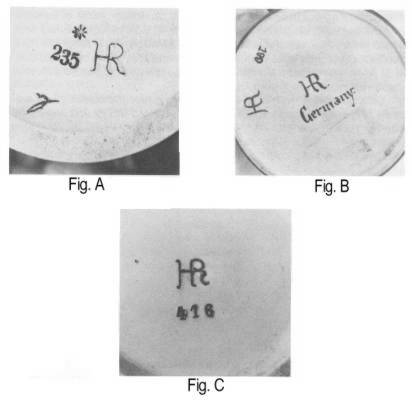|
|
~~~~~~~
|
After a period of time as sole operator Albert Hauber took on a new partner, his name was Hans Reuther. Reuther may have joined the firm prior to 1882 but this date is used because it is the first time his name appears as a partner in the Freising factory. Hauber & Reuther continued to produce contemporary stoneware but it was now marked with the "type 1a," incised HR logo. The small font model numbers were continued, as were the "decorator's initials" and "quality control marks." The large, "type 3" capacity mark that now came into use was used only during this production period. The threaded pieces also lost their Merkelbach & Wick appearance and became something uniquely Hauber & Reuther. Business was good and HR produced steins for four other marks; "LB&C," "TW," "A. Wahnschaffe" and one "Plato & Co.". Note also that some of the character steins have now acquired thumblifts. Prior to 1882, the Freising factory also supplied August Saeltzer with steinzeug blanks. For some examples of August Saeltzer decorated Freising steins, CLICK HERE. Despite the fact that business was good, stoneware production ended in 1886 when the Westerwald clay supplies were simultaneously cut off to Regensburg and Freising. The clay had been supplied to Regensburg for over eleven years and to Freising for ten. I believe Reinhold Hanke had given his personal guarantee to supply the clay, but when he died the guarantee died with him and his heirs stopped the deliveries. This loss of raw material caused Hauber & Reuther to change their product line from stoneware to porcelain. If Hanke was ill for a period of time before his death, HR may have had some warning that the supply of raw materials would be cut off. This would have allowed them to prepare for the transition in production, and explain why it seems to have taken place very quickly. Around 1882, "Old German" style stoneware and narrow bodied character steins remaining from earlier production periods became the first Freising/HR steins to be painted in full color and marked with an inked on HR mark. This is the first use of the "type 5," inked on mark. This mark was only one of eight new HR marks that would appear over the next few years. Gerz produced stoneware for HR with the "type 4," incised HR logo probably to fill the backlog of stoneware orders, or as replacement pieces and porcelain production, using a clay that could be acquired locally, was underway in Freising before the end of 1886. ~~~~~~~
This is the "type 3," large capacity mark along with the small font model number. The HR logo now makes its appearance for the first time in the form of the "type 1a," incised logo. This logo was used from 1882 through part of 1886. ~~~~~~~  These are the HR marks as they are illustrated in Mike Wald's "HR Steins" published in 1980. Fig. A is identified as HR mark #1, Fig. B as HR mark #2 (both marks were considered variants of the same mark), and Fig. C as HR mark #3. However, it is now evident that the two marks in Fig. B are not the same mark, bringing the number of marks illustrated in the photos above to four. In addition to those four I've identified another four for a total of eight. As you can see in "Fig. A" above, the Quality Control Marks and Decorator's Initials continued to be used, now in combination with the "type 1a" HR mark, proving beyond a doubt that HR indeed manufactured steins, and that they were manufactured in Freising. ~~~~~~~
HR Logos/Marks - To find the descriptions and usages of each of these logos/marks you may continue by using the link at the bottom of the page, or you can click on each of the marks above to go directly to that particular page, then use your "Back" button, NOT the link at he bottom of the page, to return here. HR EARLY ERA EXAMPLES
|